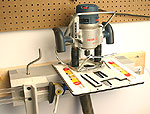 |
It's far more than a dovetail machine!
Click image to enlarge |
LittleRatTM Review
Your imagination is all that holds it back
Text & Photos by Tom Hintz
During the initial testing of the LittleRatTM, I was a little skeptical of its capabilities and usefulness in a home woodworking shop. That skepticism quickly changed to interest and this became one of the longest pre-review testing programs I have done.
In the end, I found that there is far more to the LittleRatTM than meets the eye.
Initial Impressions
The LittleRatTM kit contains an interesting mix of high-tech extrusion-based machinery and ancient technology. The main structure of the LittleRatTM consists of two heavy-duty aluminum extrusions that show exceptional fit and finish. The plastic or composite parts are cleanly manufactured and the major components secured by surprisingly large, high-quality Allen screw fasteners.
Almost as a counterpoint to the rest of the LittleRatTM kit is a bristle brush right out of the middle ages. Though inspired in its application, the preparation is a bit consternating.
Instructions
The LittleRatTM instruction manual is actually very complete and supplemented by numerous professionally done illustrations. The LittleRatTM basic capabilities are explained, as are related setup procedures. Descriptions of shop-built jigs are sprinkled throughout the manual and in a special "Jigs" section. These discussions of jigs should be considered primers as the design of the LittleRatTM makes them a cheap and effective way to expand its capabilities in a big way.
American users will have to get used to and in some cases, decipher, the British jargon that peppers the manual. Investing a little time reading the manual to familiarize yourself with these terms would be time well spent. It soon becomes apparent that "rebates" can mean dados as well as a type of refund, "trenching" does not always involve a shovel and "fixing" can mean clamping a piece in place rather than repairing something.
In most instances, the context in which these terms are used along with accompanying illustrations provide enough clues to figure out the American translation.
Assembly
The LittleRatTM arrives almost completely assembled, something to be appreciated when inspecting the sliding arm mechanism. What assembly is left for the consumer involves a few screw-on pieces to prepare the unit for installation and use.
The biggest chance for having to modify a LittleRatTM component understandably comes when installing the router. The LittleRatsTM router plate comes drilled to fit many common routers but some brands or specific models may require drilling and countersinking of the plate from below.
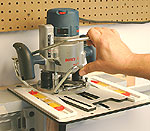 |
The PlungBar is especially handy when dropping the bit directly into the wood.
Click image to enlarge |
A Bosch 1617EVS router (2 ¼ HP) in its standard plunge base was used throughout our testing of the LittleRatTM. The factory-drilled mounting holes in the LittleRatTM plate fit the Bosch plunge base without modification.
PlungeBarTM
A plunge base router is required on the LittleRatTM. While most plunge bases can be used as-is, WoodRatTM (the parent company) offers a PlungeBarTM accessory that makes lowering the router a one-hand operation. This is especially handy when plunging the bit into the wood, such as when cutting mortises. The PlungeBarTM increases leverage and the distance the handle must be moved to lower the bit. Both work to afford the operator exceptional control when plunging a bit into the wood.
Installation
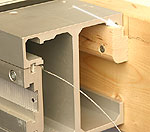 |
The toughest part of getting the LittleRat ready to use is hanging it on the wall.
Click image to enlarge |
Installing the LittleRatTM is itself unique because it hangs on the wall rather than being clamped to a bench. If your shop is like mine, clearing enough wall space to install and use the LittleRatTM can be a major effort but a worthwhile one.
The instructions say to "fix" (secure) a 24"-long piece of 2X5" material to the wall. I used a length of 2X6, 36"-long so I could "fix" it to three studs with a pair of 4"-long lag screws in each. Be sure to cut the dust channel in the wall plate as shown in the illustrations.
The LittleRatTM actually hangs from two cleats that are screwed to the wall plate. The manual says to use "softwood" but I had a couple scraps of hard maple and used them for extra security. The depth of the rabbet in which the lip of the LittleRatTM fits is important to achieving a secure, level installation.
I have no doubt that woodworkers who cannot free sufficient wall space for the recommended installation will devise a way to mount the LittleRatTM to a bench. If the LittleRatTM appeals to you, it will be a worthwhile effort.
Guides and Hardware
 |
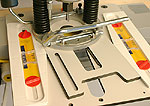 |
(Top) The straight guides keep the router and base very steady and can be locked in position for grooving and similar operations.
(Bottom) The angled guides are adjustable to match the bit diameter and to adjust the fit of dovetail joints in fine increments.
Click images to enlarge |
The rails that guide the router plate fit very well and adjust as the manual suggests. Our LittleRatTM came with aluminum straight rails and plastic angled versions. Changing from a straight front-to-back operation to an angled movement like that used in dovetailing involves four screws and a few minutes but no more. A little planning will eliminate unnecessary setup changes.
All of the hardware and fasteners used on the LittleRatTM are very good quality and appear to be over-sized for their use. Some fasteners appear longer than necessary with the LittleRatTM in its standard configuration but they can be used with various jigs or spacers, eliminating an extra set of fasteners that would no doubt be misplaced when you need them most.
Features
The most important feature of the LittleRatTM is its design. Separating front-to-back from left-to-right movements makes this an exceptionally versatile tool. Another key is substituting templates or guides with pencil lines and the operator's eye. This divergence from traditional joinery machine design means that if you can think it, the LittleRatTM can probably cut it.
The cable-operated mechanism that moves the material-holding arm left and right is solid, smooth operating and very predictable. Each 360 turn of the handle produces 1 3/8" movement of the arm and workpiece. The actual distance moved is less important than the consistency. Movement of the workpiece is slow enough for accuracy but fast enough to not be cumbersome.
As with many things on the LittleRatTM, the angled guide rails that determine the shape and size of dovetail pins take a bit of getting used to but the process is really rather straight forward. Here again, the biggest obstacle is giving yourself time to become familiar with the LittleRatTM process.
Dust Control
The dust chute within the LittleRatTM is reasonably effective but as with virtually any router-based operation, some dust will escape, especially over the top of the router plate. During testing a shop-vac and small DC (dust collector, 650 CFM) were attached to the LittleRatTM with roughly equal effectiveness.
HSS Cutters
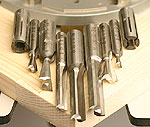 |
The #2 HSS WoodRat bit set has a good range of cutter sizes.
Click image to enlarge |
It is interesting that while carbide-tipped cutters are almost universally favored these days, the LittleRatTM recommends and sells HSS (High Speed Steel) bits. Many believe HSS cuts wood smoother than carbide in part because of the different angles ground into the cutting edges of the two materials. Another consideration is that users can sharpen HSS edges rather easily with hand-held stones or diamond cards.
Throughout experimenting with the LittleRatTM, the HSS cutters were used. They always produced very clean cuts and despite extensive use have not shown a need for sharpening to this point.
The #2 cutter set from WoodRatTM was used exclusively during our testing of the LittleRatTM. Though there were lots of "experimental" (odd) cut designs in the testing process, this set always seemed to have the bit needed for the job.
The #2 set includes: (from the WoodRat site) 8-7-12-6: Dovetail bit, for small drawers and boxes, 8-7-16-8: Dovetail bit, for boxes and large drawers, 8-7-24-12: Dovetail bit, for chests and boxes. H-6-27-15; Half-inch dovetail cutter, ideal for sliding dovetails. 8-S-42-8: 8mm Straight bit for mortising, H-S-50-10: 10mm Straight bit for deep mortises and small dovetails, H-S-50-H Straight bit for tenons and dovetail pins.
Eyeball Templates
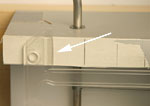 |
This pointer arrangement replaces typical guides and templates offers near total design freedom but requires aligning it from straight on to avoid small errors.
Click image to enlarge |
While the LittleRatTM is capable of hair-splitting accuracy, the level of precision achieved is heavily dependent on the operator. In talking with current users of the LittleRatTM and its big brother the WoodRatTM, it became apparent that accuracy improves with experience. In addition, operators who enjoy precision work and appreciate the design freedom of the LittleRatTM do best with it.
In place of templates or guides, the LittleRatTM uses simple pencil lines, drawn directly on the machine, to establish material positioning. Strips of acrylic plastic are included for cutting "templates" that can be used for spacing cuts in some modes. This means the only limitation to design is the diameter of the cutters. If the cutter will fit in the necessary cut paths, the only design constraint is the operator's imagination.
However, this creative freedom comes with a caveat. The angle at which the layout lines and pointer are viewed must be straight on or accuracy suffers. If viewed at an angle, the layout line and pointer can appear to be aligned when they are not. This angled view can mean the actual cut may be misplaced by the width of the layout line or more.
The instruction manual covers how these layout lines are made and used in detail. It is worthwhile to invest the time to become familiar with using this style of layout.
In The Shop
To become more familiar with how the LittleRatTM works, I dug out a pile of scrap that was undoubtedly saved for "a good reason" and sat down with the instruction manual. After going through the step-by-step instructions for the major operations the LittleRatTM seemed far less complicated. That practice also made using the indicators (called big and little cursors in the manual) to locate and tune cuts accurately much easier.
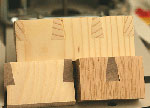 |
The LittleRat is capable of virtually any size dovetail you can imagine, but that is just the beginning.
Click image to enlarge |
After gaining a little experience with the LittleRatTM, the range of joints I could cut with it kept growing. After practicing with traditionally sized dovetails, it was easy to cut radically sized versions, both smaller and larger. One of the more intriguing experiments was cutting a single but very large dovetail, half-lapped into a simulated table leg to be used in place of more traditional mortise and tenon joints.
One of the interesting capabilities of the LittleRatTM is being able to make climb cuts on the outside edges of wood that is secured in the LittleRatTM's clamp as when cutting tenons on the ends of a board. The mechanical advantage the crank enjoys over the material arm also stabilizes the wood as it passes the bit in the climb cut mode. These specific instances aside, all other cuts must be made against the cutter rotation to prevent kicking the wood out.
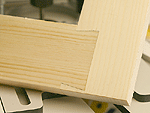 |
This half-lap dovetail joint took me less than 15 minutes to make the first time.
Click image to enlarge |
Because the LittleRatTM is essentially an upside down router table, it also cuts edge profiles, grooves and dados. The scrub brush is secured in the clamp, applying pressure that holds the board tight against the underside of the router platform. The only limitation on the size of the material is the room available to either side of the LittleRatTM. Obviously, long boards will require work supports on the in and out sides to prevent tilting during the cut.
A word of caution: Though you can see the bit working in most cases, your hands can be under the router plate at times making it very important to be aware of how you are handling the wood and how close your fingers are to the cutter. Push blocks or push sticks are still required to stay safe!
The LittleRatTM manual shows a few basic shop-made jigs that can extend the capabilities of this machine substantially. As familiarity with the LittleRatTM builds, you realize that the number of jig variations that can be made to make full use of its milling machine-like capabilities is endless.
The only real limitation in terms of material size with the LittleRatTM is its installed height from the floor and the free space to either side. The instructions suggest mounting the LittleRatTM 18 to 20" below eye level. I found it easier for me to see the bit and adjustments with the unit a bit higher relative to my height. The clearance between the LittleRatTM and the floor is more than adequate for the vast majority of projects woodworkers build.
Dislikes
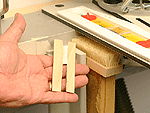 |
OK. Having to trim the brush handle is a small dislike but there were not a lot of problems to choose from!
Click image to enlarge |
Aside from the minor jargon issues mentioned earlier, my only problem with the LittleRatTM is with the scrub brush meant to hold the stock tight against the bottom of the routing table. It comes with a concave wooden handle that must be flattened so it can be glued to a piece of wood so it can be locked in the LittleRatTM's clamp at whatever height is required. If you have a bandsaw, flattening the brush is reasonably easy. For those not so equipped, readying this simple component for use can be somewhat labor intensive.
Conclusions
In terms of pure dovetailing or cutting mortise and tenon joints, the LittleRatTM is certainly capable. However, there are dozens of dedicated, less costly machines or jigs on the market that will also produce these joints. However, most lack the design freedom offered by the LittleRatTM. The LittleRatTM's independent control over the two primary axis of movement affords the operator a level of design freedom that is not possible on any other machine I am aware of.
The extensive capabilities of the LittleRatTM mean there is a learning curve that might be a bit steeper than some anticipate but the rewards make this a worthwhile effort. Once the basics of using the LittleRatTM are mastered, the true capabilities of this machine begin to emerge.
If fabricating custom parts, designing radical joinery layouts or creating eye-catching unique features for your projects are appealing, you owe it to yourself to check out the LittleRatTM.
See more about the LittleRatTM and the larger WoodRatTM at www.woodrat.com.
Do you have a comment about this page? - Email Me!
Back to the Tool Reviews List
|
![]()










